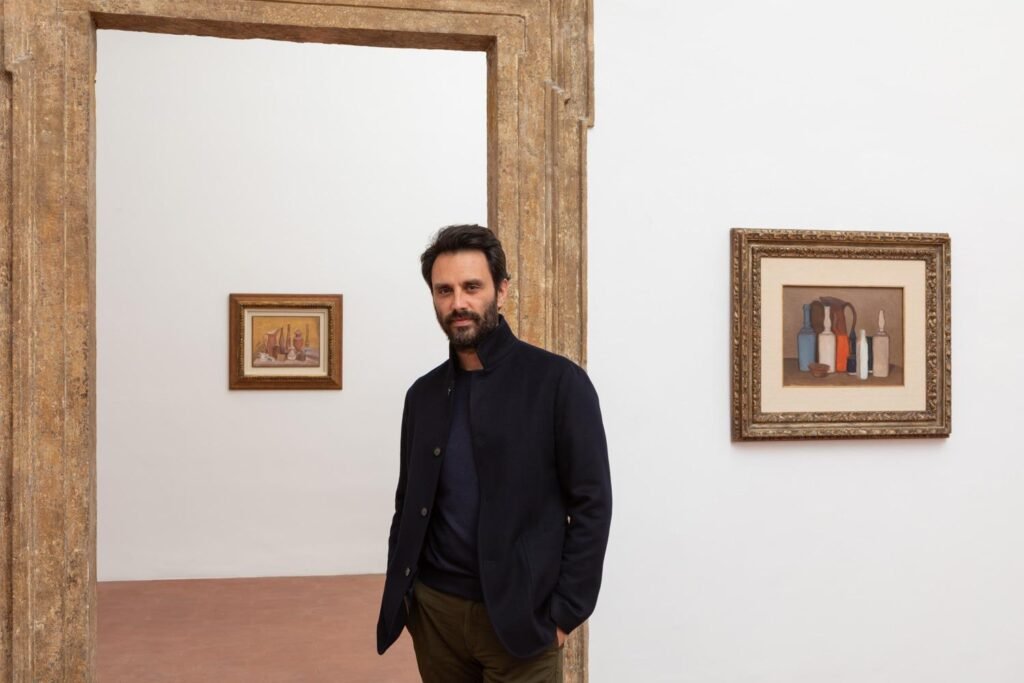
A few weeks ago, Galleria Mattia De Luca opened “Time Suspended II,” an ambitious show of work by Giorgio Morandi that brings together more than sixty works from across Morandi’s career on the occasion of the 60th anniversary of the artist’s death. Even more compellingly, the show is staged in a 19th-century townhouse on East 63rd Street off Fifth Avenue. We caught up with Mattia De Luca—who curated the show along with Marilena Pasquali, founder and director of the Giorgio Morandi Study Center in Bologna—to hear more about the exhibition and what Morandi still has to teach us.
The peg for this show is the 60th anniversary of Morandi’s death. What do you view to be his lasting legacy?
Morandi’s legacy is closely related to the exceptional nature of his persona from both an artistic and human point of view, which in his case are profoundly connected. Morandi distanced himself from the prevailing avant-garde movement and the most famous experiments of the 20th Century, maintaining very little contact with other painters of his time and dedicating his entire life to a personal and rigorous vision of art in the solitude and intimacy of his bedroom studio. In a constant effort for accuracy and the essential, his commitment to painting as a discipline is perhaps the most significant and lasting legacy of a life devoted to art in its purest and uncorrupted form.
How did you find the townhouse where the show is installed? And what spoke to you about this location?
I had organized an exhibition in this space in 2019. On that occasion, I was looking for a “home,” not a gallery. What struck me the most about this early 19th-century townhouse was that it maintained many original architectural details such as fireplaces, herringbone floors, moldings and a beautiful square formal staircase. I believe a warm and welcoming environment helps the viewers establish their personal and intimate relationship with the works. For Morandi’s exhibition, these aspects were crucial because one needs to take the right amount of time to be in the frame of mind to experience the spiritual and meditative quality of Morandi’s works in the comfort of a place that makes us feel at home.


Why do you think people seem to be so excited about exhibitions staged outside the traditional white cube gallery space?
I believe it is connected precisely to the reasons that led me to find this space, as I was explaining in the previous answer. In this case, the space helps create the warm and cozy atmosphere that encourages a more intimate connection with the works.
This show features over sixty works from a wide array of sources, including a piece previously owned by Robert Rauschenberg. How did you determine the final mix of paintings? What periods and aspects of his career did you want to cover?
Adding to the research and work that contributed to the 2022 show in Rome we continued to narrate his artistic journey from both a chronological and critical point of view. We have selected works ranging from 1913-14 up to the year of the artist’s death, 1964. A selection which, in our opinion, also provides a broad spectrum of Morandi’s different approaches and techniques. For this reason, paintings that are at first glance very similar to each other but belong to different moments of his production are on display close to each other: the public is given the chance to recognize and appreciate the small variations in composition or perspective which informed of a specific moment of Morandi’s life.
We live in an age when some absolute ding dong paid $5000 for a still life of an Uncrustble. Why does the modern public still crave still lifes?
Still life is a genre that spans art history, and painters have always had to measure themselves against it—Edouard Manet once called it “the touchstone of painting.” It is something we immediately recognize and connect with not just because it is rooted in our sensibility as a genre but also because it captures the essence of its time, offering a glimpse of the social, economic, and cultural context in which it is created. It could be the opulence of a Baroque still life or the austerity of Morandi’s compositions, but hence can also lend itself to the accessibility and banality of junk food—a sign of a fast-paced and consumerist culture disguised behind a formally perfect image that recalls the technique of the Old Masters.
Morandi lived in a time when Italy faced political strife. Does his work have anything to teach those who might be going through similar political difficulties?
Morandi lived through two world wars, an experience that is very difficult to grasp today from such a historical distance. He initially looked at the great political changes of his time with trust and hope but was soon deeply disenchanted by the outcome of the events. He also personally paid with a brief incarceration for having distanced himself from the political issues and having friends among those writers, poets and painters who openly stood against Fascism. His work teaches us a very personal, cultural, human form of resistance carried out with the perseverance and consistency of solitary work. Certainly a difficult lesson but also a way to underscore those unshakable values that help humanity overcome difficult times.
What do you hope people leave this exhibition thinking?
I hope people will leave the show carrying the memory of something unique and moving. The memory and feeling of an experience that allowed them to grasp the extraordinary ethos of an artist and his timeless art.






